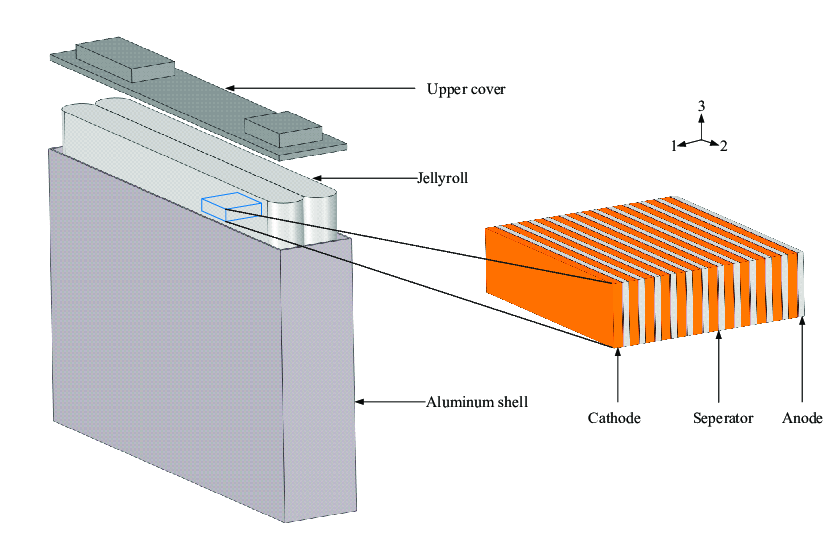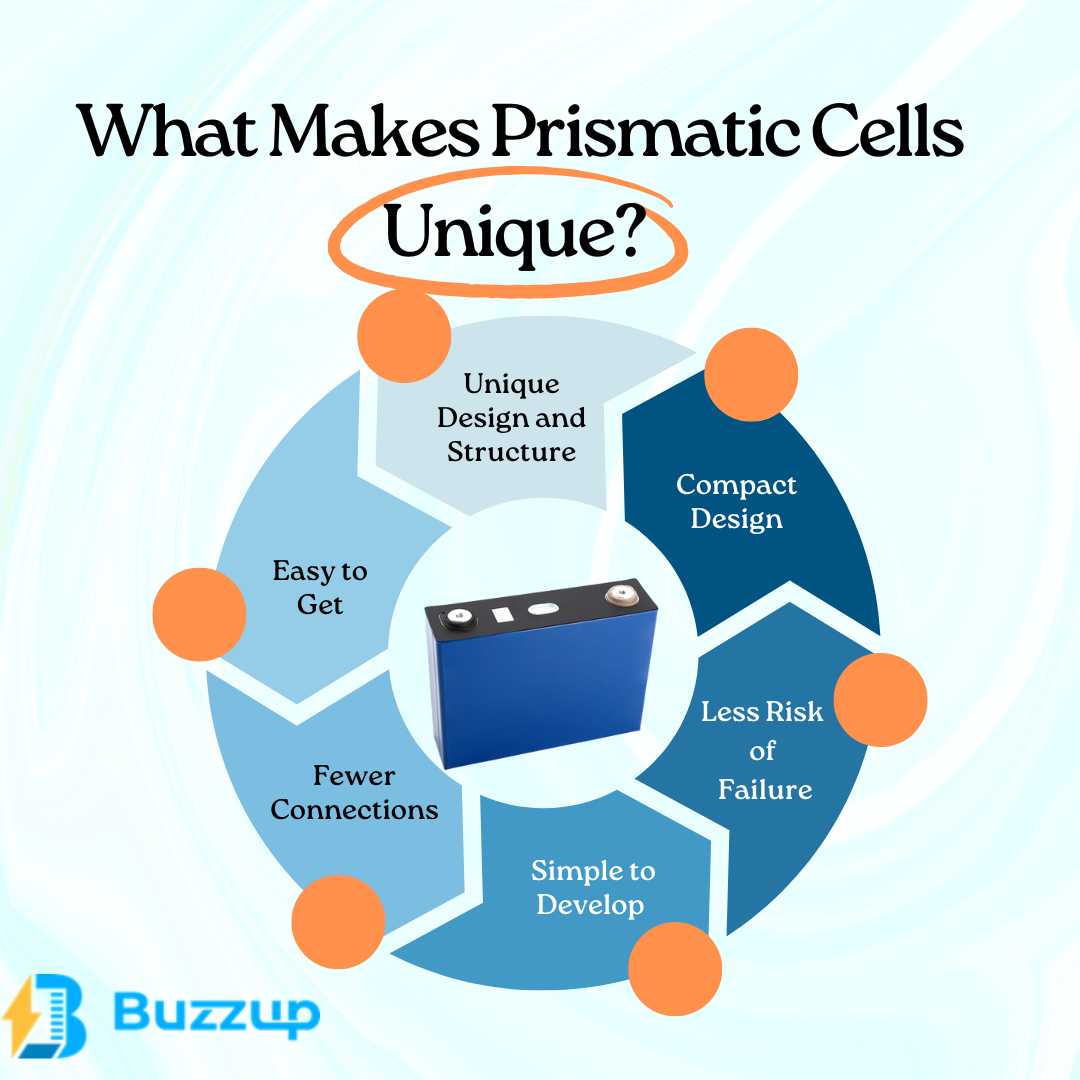
As we all know, lithium cells are the frontrunner in today’s world because of their several benefits. Yet, not all batteries are equal; some out-powers others in quality.
The market offers various Lithium-ion batteries. It provides you with options like prismatic, cylindrical, and lipo. The technology behind prismatic cells is new and still emerging.
For that reason, these cells are all set to catalyst disruption in the battery industry. The design of these cells powers them to excel in domestic and commercial settings.
What Are Prismatic Cells?
These cells have a hard shell around their chemistry. These cells store power as chemical energy and release electrical current.
Prismatic cells are large. Hence, they are too bulky to work with little electronics like toys or mobile phones. These cells fall into the category of electrochemical cells.
Prismatic cells have a case with three electrode sheets–anode, separator, and cathode. You can arrange electrodes vertically, stretch or compress as per need. As a result, the cells are apt for tasks that need high-energy storage.
The cell covering comes with sturdy walls. For this reason, these batteries are best for use in electric cars and energy storage.
The rectangular form of these cells is ideal in different applications.
What Is the History Behind Prismatic Cells?
Prismatic cells have been present since the 1980s. They have only begun to make headway in the automotive, building and other sectors.
Their designs call for space efficiency. Also, the gigantic size makes them impractical for daily use.
Why Do These Cells Get the Name Prismatic?
‘Prismatic Cells’ derives its name from the hexagonal shape of cells. The shape is due to machine welding. A range of shapes and sizes of these cells result from different assembling of cells. It allows a wide range of applications.
You can identify the battery model type by looking at the cell design and structure. Consequently, these cells have an appearance of a prism. Likewise, cylindrical cells are somewhat tube-like. On the other hand, pouch cells are sack-like.
Prismatic lithium battery cells are lightweight, well-packed and cost-effective. Their low profile makes them ideal for use in electric cars and smartphones.
Are Prismatic Cells Superior?
We must talk about the cylindrical cells first. Well, they cost more and even don’t last as much as prismatic ones.
Likewise, the prismatic option is fast gaining ground due to its high energy output. Also, these cells have a tight and close-packed design that allows their use in a wide range of applications.
Prismatic cells fit well in various roles, hence demonstrating their superiority. The battery size and the virtual devices it powers are factors to consider. Small devices often use these cells rather than other.
Notably, these cells are less prone to malfunction when moved or shaken. These features make them the best fit for mobiles and stationary devices.
How Do Manufacturers Make Prismatic Cells?

Image source: https://www.researchgate.net/figure/Composition-of-the-prismatic-cell_fig1_340835448
This cell consists of –
- An anode
- A cathode
- A separator
There are electrolytes within a metallic or rigid plastic block. Different materials make the anode in a prismatic cell.
The electrode layers are mountable, unlike in the case when jelly rolls are in use. One can use carbon or small particles like germanium or crystalline silicon to make it.
Lithium battery has one or two rows of cells. A metal sheet of a certain width and curve creates the prismatic core. Also, the top and base must be sealed properly.
The electrode assembly lies in the casing. It has a cathode, anode, and separator material.
How Does a Prismatic Cell Function?
A prismatic cell becomes the best power source when its usage is correct. It ranges from a few Ah for cellphones and laptops to several hundred Ah for electric vehicles. Therefore, these batteries are suitable for many setups that need power and efficiency.
When overheated, the cell components release electrons. Flyers, a modified substance, allow easy entry into the machine. A mechanical framework houses a number of prismatic lithium-ion cells connected in a serial or parallel fashion.
Prismatic li-ion cells lie in a frame either connected or alongside. The new cells are modular due to their handy and layered design.
Do Prismatic Cells Come at a High Price?
Prismatic Lithium batteries are synonyms for high quality. This quality comes at a cost. This cost becomes an investment due to the long shelf life and additional output.
Larger cell sizes drive up the price. As a result, they are perfect for making tiny battery modules. It provides power to electronic gadgets like smartphones and laptops.
You might get a better deal if you talk to a top battery company like Buzzup.
What Makes Prismatic Cells Unique?
The prismatic (LiFePO4) cells in batteries are reliable and robust. They are suitable for storing renewable energy in battery packs. Above all, they are replaceable for future upgrades.
The screw-in connectors make assembling the cells as easy as putting together LEGO blocks. Also, soldering is not required.
1) Unique Design and Structure
Prismatic li-ion cells are slim and easy to stack. So it allows them to have a distinct narrow rectangular form. These cells have a sturdy steel or aluminium casing. This allows for more effective stacking of the li-ion cells that energize them.
Designers using prismatic cell batteries have greater creative freedom. This is due to the flexibility in developing products that incorporate them.
2) Compact
You can find many little more compact versions of prism-shape cells. So they are basically much smaller than other types. Thus, it makes them best suitable for many electronic equipment.
Cylindrical ones are more extended and broader. In contrast, prismatic ones have a shape that makes it easy to combine them. Four cells can join to create larger structures, such as a 12-volt battery pack.
3) Less Risk of Failure
These cells are less likely to get damaged by motion and vibrations. Prismatic cells are ideal for small electronics. This includes devices like smartphones and digital watches. These provide more security and are safer to use.
4) Simple to Develop
Extending battery life concerns many people. It must be in most situations. Prismatic LiFePO4 cells are easier to expand and develop, making them a good choice.
5) Fewer Connections
Prismatic can have more space than any other cell. As a result, fewer cells can provide an equal power. Prismatic cell batteries need less welding of wires for each size.
6) Easy to Get
Nowadays, manufacturers prefer producing prismatic cells over any other type of cell. Thus, finding genuine manufacturers is pretty easy.
What Makes Prismatic Cells Useful?

We live in the age of prismatic cells. These cells are much better than other batteries. They don’t have harmful materials inside, so they are safer. These cells have many uses and different purposes than regular batteries.
1) Space
These cells come in a square shape to make them suitable for better stacking. They can store more energy because of their bigger size. You can also find them in huge sizes. They often use these cells in battery packs for cars. They come in capacities from 20 to 50Ah. These cells have welded aluminium cases.
2) Greater Unit Capacity
It has a solid frame to store more energy than cylindrical cells. This feature makes it popular with people. It is beneficial for those interested in battery DIY and high-capacity jobs. It eliminates the need to combine many small cells into one large one.
3) Adaptability
The primary upper hand of prismatic cells lies in their flexibility. They come in many sizes or shapes to fit different installation sites.
4) Greater Consistency
Prismatic cells have a high individual capacity. Hence, they can achieve their rated capacities with fewer cells than other types. It leads to more excellent stability and uniformity.
5) Lightweight
Prismatic cells have lightweight exteriors. Mostly, steel and Aluminium go into the making of the cells. They are essential for uses such as energy storage in recreational vehicles.
6) Stability of Battery Packs
A battery pack with prismatic cells has fewer cells. It means the BMS can manage each cell in the battery pack. It results in excellent stability in the system.
7) Enhanced Safety
LiFePO4 prismatic cells made using winding or laminating techniques are more reliable. This cell has better energy efficiency due to the design and the way they get manufactured.
A battery pack packed with these cells is safe. It is because they need fewer cells to achieve the desired rated capacity. As a result, BMSs are becoming more popular.
Where Can You Use Prismatic Cells?
Lithium-ion prismatic cell batteries go into gadgets where mobility is essential. They can generate more power for EVs than the standard li-ion cells.
The cells power mobile phones, laptops and small electronic gadgets. These modern batteries are gaining traction in other critical industries. Energy storage and hybrid cars are frontrunners in the use of these cells.
What Qualities Should You Focus on When Shopping for Prismatic Cells?
Making a battery takes much more than prismatic cells and involves many intricacies.
- Are there prismatic cells in the battery?
- Do prismatic cells adhere to worldwide norms?
- What about the joints?
- What material is used for housing around the cell?
- Are charge and discharge checks performed on the last assembly?
Is Tesla Making Use of Prismatic Cells?
The modern cylindrical battery cells are what Tesla is using. This company employs cylindrical cells for their outstanding durability and lower risks. A fire is unlikely to break out along the perimeter of a cylindrical cell. And that is why cylindrical cells become a safe bet.
As per reports, Tesla cars use one of four battery types: the 18650, 2170, 4680, or prismatic Tesla battery.
Is It Necessary to Compress Prismatic Cells?
The process of compressing cells is to compress the aluminium LFP cell casing in a fixture. It is to prevent the inside parts from delaminating.
Delamination shortens the useful life of cells and strains their electrical connections. All cell types need compression, excluding cylindrical cells.
So, compressing the prismatic cell is necessary for the plastic or aluminium casing. Swelling and early battery failure are signs that compression was inadequate.
Is the Prismatic Cell a New Standard in Batteries?
We all know how energy storage technology drives the electric vehicle market. But this technology is still evolving. The jury is still out on the matter. It is too early to predict whether prismatic or cylindrical cells will be the new standard.
Yet, the belief is that the prismatic cells will prevail over the cylindrical cells in the long run. They will finally enter the electric vehicle market and replace cylindrical cells.
Also, Tesla has announced plans to equip its base models with these batteries. The company is already using it in some models.
Where Can You Buy Prismatic Cells of the Highest Quality?
The prismatic batteries have seen a rapid growth in usage. There are a few businesses engaged in the manufacturing of these cells. Many players are dependent on outsourcing for the manufacturing of the cells.
Buzzup is the market leader in the production of superior batteries. This company makes among the best LiFePO4 prismatic cells.
Final Thoughts!
So here it completes your study on prismatic cells. The future of power storage batteries is beyond doubt in prismatic LiFePO4 cells. A prismatic cell is your remedy if the application has space constraints. And also if a higher price tag is acceptable to you.
With so many options, one can be in a dilemma about which lithium cells best suit the purpose. If you need clarification, talk to a professional partner like Buzzup. The assistance in choosing the lithium cells will work best for you.
On rare occasions, the excessive charging leads to overheating. As a result, it can cause the battery cells to burst. It is still a universal challenge. Lithium batteries must pass the most sovereign security tests and inspection measures.


